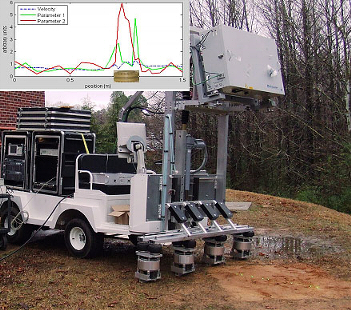- Biomedical Applications of TRA
- Drug delivery
- Charging batteries
- Leadless Neurostimulation
- Deep Brain Stimulation
- Non-Medical Applications of TRA

Military Application: Land Mine Detection
Artann in collaboration with Los Alamos National Laboratory conducted a project “Land Mine Detection by Time Reversal Acousto-Seismic Method” supported by the Department of Defense. Artann developed a method of land mine detection based on the combination of TRA focusing of seismic waves with nonlinear acoustic method. The feasibility of the developed approach was proven in the laboratory test and in small scale field experiments conducted at the facilities of the US Army Night Vision and Electronic Sensors Directorate. The Artann’s technology of TRA focusing of seismic waves at multiple points on the ground was tested in the system for acoustic detection of mines developed in National Center of Physical Acoustics, University of Mississippi. We conducted experiments exploring the changes of the various features of ground vibration at different levels of excitation. Significant differences in nonlinear effects in ground vibration above the mine and away from the mine were detected. Based on these findings we developed a technique that excites a small region of soil with successive seismic waves of varied amplitudes. Analysis of vibration waveform and spectrum at this point and subsequent measurement points build a map that can be used for landmine detection. Preliminary experiments demonstrated high sensitivity of the TRA method.
Nondestructive testing
Structural Health Monitoring
In a project “Time Reversal Acoustic Structural Health Monitoring Using Array Of Embedded Sensors" funded by NASA and conducted in collaboration with Los Alamos National Laboratories, Artann developed a new approach to in-situ nondestructive evaluation (NDE) for airspace, automotive, and other industries based on TRA principles. TRA-based focusing of ultrasonic waves in combinations with embedded sensors and nonlinear acoustic methods has a potential of highly improving sensitivity of conventional acoustic NDE methods. The TRA focusing system provides high concentration of the ultrasound energy in the tested region, thus enhancing nonlinear acoustic effects (for example, higher harmonic generation). The analysis of TRA signal distortion and nonlinear acoustic effects in the different paths of propagation provides information necessary for tomographic mapping of damage and degradation.
Nondestructive Evaluation of Composite Materials
In a project funded by the DOD/Air Force “Vibration Based Structural Health Monitoring using Time Reversal Acoustics”, Artann developed a prototype of a portable device based on the TRA principles for assessment of fiber composites and fiber hybrids, for quality control in the manufacturing, and the assessment of structural integrity of materials prior to assembly, immediately following assembly, and during operational life. Although immediate applications of the device are for detection of flaws, cracks, and progressive damage of composite material parts, the approaches and instrumentation developed in Artann is also applicable to a multitude parts, structures and samples featuring a variety of materials and shapes, including all composite materials, carbon and graphite fiber, metals, glass, sandstone, and concrete parts.
Nonlinear Time Reversal Acoustic Method of Friction Stir Weld Assessment
The goal of project “Nonlinear TRA for Stir Wield Assessment” funded by NASA was to prove that nonlinear TRA methods can serve as a sensitive means for non-destructive evaluation in a particular application: detection of defects in the friction stir welds (FSW). The results of the study fully confirmed and exceeded our expectations for the effectiveness of the nonlinear TRA in FSW assessment. Various methods of nonlinear effects measurements: harmonics and combination frequency generation, phase inversion, and varied amplitude, were investigated and the simplest and fastest high harmonic generation method was chosen for FSW sample scans. The measurements demonstrated the significant increase of nonlinear effects in defective FSW in comparison with the good quality FSW. The developed Nonlinear TRA system provided mapping of the weld nonlinear parameter that allowed localization of defected area.